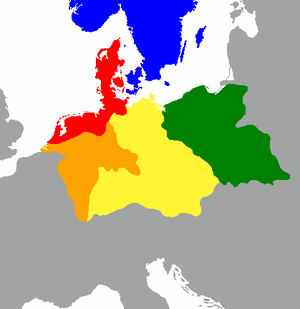East Germanic languages
| East Germanic | |
|---|---|
| Ethnicity: | East Germanic peoples |
| Geographic distribution: | Formerly central Europe and parts of eastern Europe, including Crimea |
| Linguistic classification: |
|
| Subdivisions: | |
| ISO 639-5: | gme |
| Glottolog: |
(not evaluated) goth1244 (Gothic)[1] |

The East Germanic languages are a group of extinct Germanic languages of the Indo-European language family spoken by East Germanic peoples. The only East Germanic languages of which texts are known are Gothic and its dialect, Crimean Gothic; other languages that are assumed to be East Germanic include Vandalic and Burgundian, though very few texts in these languages are known. Crimean Gothic is believed to have survived until the 18th century.
History
By the 1st century CE, the writings of Pomponius Mela, Pliny the elder, and Tacitus indicate a division of Germanic-speaking peoples into large groupings with shared ancestry and culture. (This division has been appropriated in modern terminology about the divisions of Germanic languages.)
.png)
Based on accounts by Jordanes, Procopius, Paul the Deacon and others; linguistic evidence (see Gothic language); placename evidence; and archaeological evidence, it is believed that the East Germanic tribes, the speakers of the East Germanic languages related to the North Germanic tribes, had migrated from Scandinavia into the area lying east of the Elbe.[2] In fact, the Scandinavian influence on Pomerania and northern Poland from period III onwards was so considerable that this region is sometimes included in the Nordic Bronze Age culture (Dabrowski 1989:73).
There is also archaeological and toponymic evidence that Burgundians lived on the Danish island of Bornholm (Old Norse: Burgundaholmr), and that Rugians lived on the Norwegian coast of Rogaland (Old Norse: Rygjafylki).
Groups
Groups identified as East Germanic tribes include:
Traditionally the Langobards were classified as East Germanic, however, the Lombardic language and Yiddish are now considered by many specialists to be close to Old High German, especially its Upper German dialects, which would make a classification as West Germanic rather than East Germanic more sensible.
See also
- East Germanic strong verb
- Germanic verb
- Ingvaeonic languages
- Irminonic languages
- Istvaeonic languages
- North Germanic languages
- West Germanic languages
- Balto-Slavic languages
Notes and References
- ↑ Hammarström, Harald; Forkel, Robert; Haspelmath, Martin; Bank, Sebastian, eds. (2016). "Gothic". Glottolog 2.7. Jena: Max Planck Institute for the Science of Human History.
- ↑ The Penguin atlas of world history, Hermann Kinder and Werner Hilgemann; translated by Ernest A. Menze; with maps designed by Harald and Ruth Bukor. Harmondsworth: Penguin Books. ISBN 0-14-051054-0, 1988. Volume 1, p. 109.
- Dabrowski, J. (1989) Nordische Kreis und Kulturen Polnischer Gebiete. Die Bronzezeit im Ostseegebiet. Ein Rapport der Kgl. Schwedischen Akademie der Literatur, Geschichte und Altertumsforschung über das Julita-Symposium 1986. Ed Ambrosiani, B. Kungl. Vitterhets Historie och Antikvitets Akademien. Konferenser 22. Stockholm. ISBN 91-7402-203-2
- Demougeot, E. La formation de l'Europe et les invasions barbares, Paris: Editions Montaigne, 1969–74.
- Kaliff, Anders. 2001. Gothic Connections. Contacts between eastern Scandinavia and the southern Baltic coast 1000 BCE – 500 CE.
- Musset, L. Les invasions: les vagues germanique, Paris: Presses universitaires de France, 1965.
- Nordgren, I. 2004. Well Spring of The Goths. About the Gothic Peoples in the Nordic Countries and on the Continent.